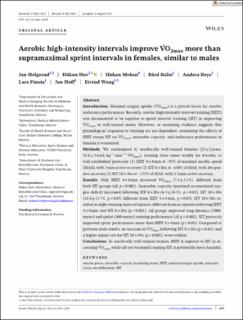| dc.contributor.author | Helgerud, Jan | |
| dc.contributor.author | Hov, Håkon | |
| dc.contributor.author | Mehus, Håkon Andre | |
| dc.contributor.author | Balto, Bård | |
| dc.contributor.author | Boye, Anders Johan Nesheim | |
| dc.contributor.author | Finsås, Lars | |
| dc.contributor.author | Hoff, Jan | |
| dc.contributor.author | Wang, Eivind | |
| dc.date.accessioned | 2024-03-20T12:14:09Z | |
| dc.date.available | 2024-03-20T12:14:09Z | |
| dc.date.created | 2023-09-08T12:40:55Z | |
| dc.date.issued | 2023 | |
| dc.identifier.citation | Helgerud, J., Hov, H., Mehus, H. A., Balto, B., Boye, A. J. N., Finsås, L., Hoff, J. & Wang, E. (2023). Aerobic high-intensity intervals improve V̇O<inf>2max</inf> more than supramaximal sprint intervals in females, similar to males. Scandinavian Journal of Medicine & Science in Sports. 33(11), 2193-2207. doi: | en_US |
| dc.identifier.issn | 1600-0838 | |
| dc.identifier.uri | https://hdl.handle.net/11250/3123386 | |
| dc.description.abstract | Introduction: Maximal oxygen uptake (V̇O2max) is a pivotal factor for aerobic endurance performance. Recently, aerobic high-intensity interval training (HIIT) was documented to be superior to sprint interval training (SIT) in improving V̇O2max in well-trained males. However, as mounting evidence suggests that physiological responses to training are sex-dependent, examining the effects of HIIT versus SIT on V̇O2max, anaerobic capacity, and endurance performance in females is warranted. Methods: We randomized 81 aerobically well-trained females (22 ± 2 years, 51.8 ± 3.6 mL∙kg−1∙min−1 V̇O2max), training three times weekly for 8 weeks, to well-established protocols: (1) HIIT 4 × 4 min at ~95% of maximal aerobic speed (MAS), with 3 min active recovery (2) SIT 8 × 20 s at ~150% of MAS, with 10 s passive recovery (3) SIT 10 × 30 s at ~175% of MAS, with 3.5 min active recovery. Results: Only HIIT 4 × 4 min increased V̇O2max (7.3 ± 3.1%), different from both SIT groups (all p < 0.001). Anaerobic capacity (maximal accumulated oxygen deficit) increased following SIT 8 × 20 s (6.5 ± 10.5%, p < 0.05), SIT 10 × 30 s (14.4 ± 13.7%, p < 0.05; different from HIIT 4 × 4 min, p < 0.05). SIT 10 × 30 s resulted in eight training-induced injuries, different from no injuries following HIIT 4 × 4 min and SIT 8 × 20 s (p < 0.001). All groups improved long-distance (3000-meter) and sprint (300-meter) running performance (all p < 0.001). SIT protocols improved sprint performance more than HIIT 4 × 4 min (p < 0.05). Compared to previous male results, no increase in V̇O2max following SIT 8 × 20 s (p < 0.01), and a higher injury rate for SIT 10 × 30 s (p < 0.001), were evident. Conclusions: In aerobically well-trained women, HIIT is superior to SIT in increasing V̇O2max while all-out treadmill running SIT is potentially more harmful. | en_US |
| dc.language.iso | eng | en_US |
| dc.publisher | Wiley | en_US |
| dc.relation.uri | https://doi.org/10.1111/sms.14470 | |
| dc.rights | Navngivelse 4.0 Internasjonal | * |
| dc.rights.uri | http://creativecommons.org/licenses/by/4.0/deed.no | * |
| dc.title | Aerobic high-intensity intervals improve V̇O<inf>2max</inf> more than supramaximal sprint intervals in females, similar to males | en_US |
| dc.title.alternative | Aerobic high-intensity intervals improve V̇O<inf>2max</inf> more than supramaximal sprint intervals in females, similar to males | en_US |
| dc.type | Peer reviewed | en_US |
| dc.type | Journal article | en_US |
| dc.description.version | publishedVersion | en_US |
| dc.rights.holder | © 2023 The Author(s) | en_US |
| dc.source.pagenumber | 2193-2207 | en_US |
| dc.source.volume | 33 | en_US |
| dc.source.journal | Scandinavian Journal of Medicine & Science in Sports | en_US |
| dc.source.issue | 11 | en_US |
| dc.identifier.doi | 10.1111/sms.14470 | |
| dc.identifier.cristin | 2173489 | |

